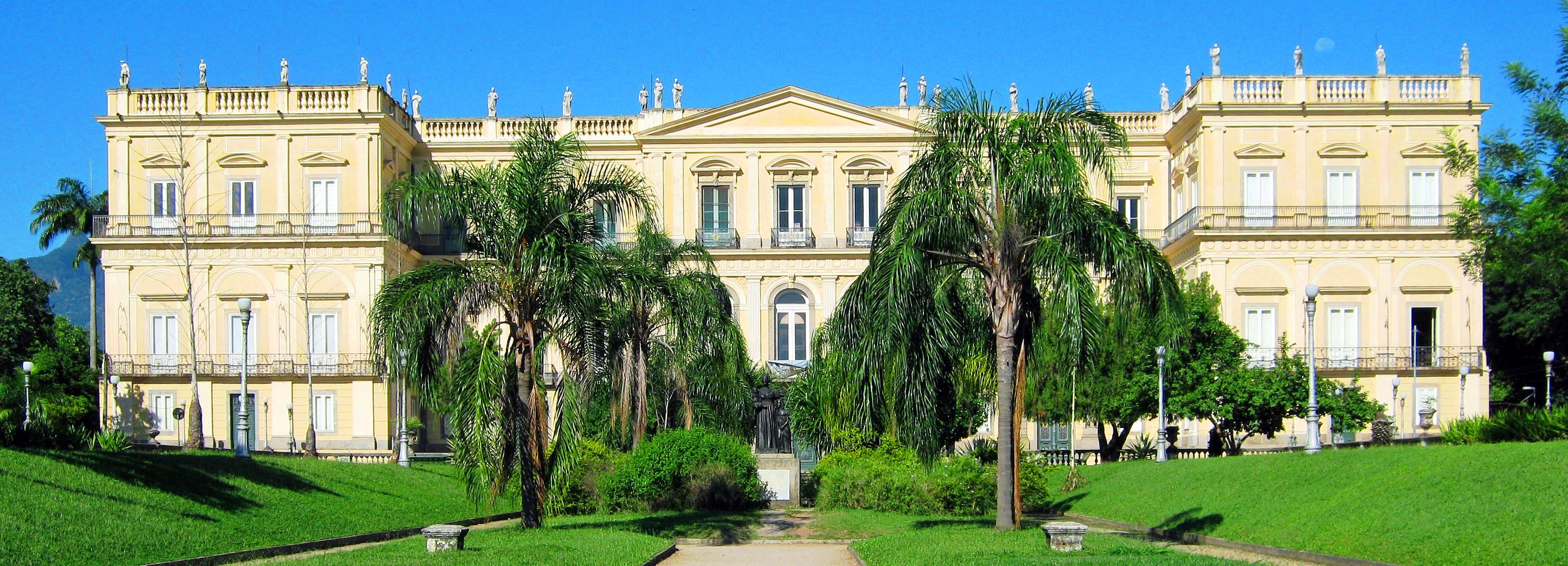National Museum of Brazil
 The National Museum of Brazil () is the oldest scientific institution of Brazil. It is located in the city of Rio de Janeiro, where it is installed in the Paço de São Cristóvão (Saint Christopher's Palace), which is inside the Quinta da Boa Vista. The main building was originally the residence of the House of Braganza in colonial Brazil, as the Portuguese royal family between 1808 and 1821 and then as the Brazilian imperial family between 1822 and 1889. After the monarchy was deposed, it hosted the Republican Constituent Assembly from 1889 to 1891 before being assigned to the use of the museum in 1892. The building was listed as Brazilian National Heritage in 1938 and was largely destroyed by a fire in 2018.
The National Museum of Brazil () is the oldest scientific institution of Brazil. It is located in the city of Rio de Janeiro, where it is installed in the Paço de São Cristóvão (Saint Christopher's Palace), which is inside the Quinta da Boa Vista. The main building was originally the residence of the House of Braganza in colonial Brazil, as the Portuguese royal family between 1808 and 1821 and then as the Brazilian imperial family between 1822 and 1889. After the monarchy was deposed, it hosted the Republican Constituent Assembly from 1889 to 1891 before being assigned to the use of the museum in 1892. The building was listed as Brazilian National Heritage in 1938 and was largely destroyed by a fire in 2018.Founded by King João VI of Portugal, Brazil and the Algarves on 6 June 1818, under the name of "Royal Museum", the institution was initially housed at the Campo de Santana park, where it exhibited the collections incorporated from the former House of Natural History, popularly known as ''Casa dos Pássaros'' ("House of the Birds"), created in 1784 by the Viceroy of Brazil, , as well as collections of mineralogy and zoology. The museum foundation was intended to address the interests of promoting the socioeconomic development of the country by the diffusion of education, culture, and science. In the 19th century, the institution was already established as the most important South American museum of its type. In 1946, it was incorporated into the Federal University of Rio de Janeiro.
The National Museum held a vast collection with more than 20 million objects, one of the largest collections of natural history and anthropological artifacts in the world, encompassing some of the most important material records regarding natural science and anthropology in Brazil, as well as numerous items that came from other regions of the world and were produced by several cultures and ancient civilizations. Built-up over more than two centuries through expeditions, excavations, acquisitions, donations and exchanges, the collection was subdivided into seven main nuclei: geology, paleontology, botany, zoology, biological anthropology, archaeology, and ethnology. The collection was the principal basis for the research conducted by the academic departments of the museumwhich are responsible for carrying out activities in all the regions of the Brazilian territory and several places of the world, including the Antarctic continent. The museum holds one of the largest scientific libraries of Brazil, with over 470,000 volumes and 2,400 rare works.
In the area of education, the museum offers specializations, extension and post-graduation courses in several fields of the knowledge, in addition to hosting temporary and permanent exhibitions and educational activities open to the general public. The museum manages the ''Horto Botânico'' (Botanical Garden), adjacent to the ''Paço de São Cristóvão'', as well as an advanced campus in the city of Santa Teresa, in Espírito Santothe Santa Lúcia Biological Station, jointly managed with the Museum of Biology Prof. Mello Leitão. A third site, located in the city of Saquarema, is used as a support and logistics center for field activities. Finally, the museum is also dedicated to editorial production, outstanding in that field the ''Archivos do Museu Nacional'', the oldest scientific journal of Brazil, continuously published since 1876.
The palace, which housed a large part of the collection, was destroyed in a fire on the night of 2 September 2018. The building had been called a "firetrap" by critics, who argued the fire was predictable and could have been prevented. The fire began in the air-conditioning system of the auditorium on the ground floor. One of the three devices did not have external grounding, there was no individual circuit breaker for each of them, and a wire was without insulation in contact with metal. In the wake of the fire, the ruined edifice was being treated as an archaeological site and undergoing reconstruction efforts, with a metallic roof covering a 5,000 m2 area including debris.
In 2019, more than 30,000 pieces of the imperial family's past were found during archaeological works on Rio de Janeiro Zoological Garden nearby, part of Quinta da Boa Vista. Among the finds are many items such as fragments of crockery, cups, plates, cutlery, horseshoes and even buttons and brooches with imperial coat of arms from military clothing. Those items were given to the museum. After being destroyed by fire, the National Museum has received donations to the amount of R$ 1.1 million in seven months towards rebuilding efforts. Provided by Wikipedia